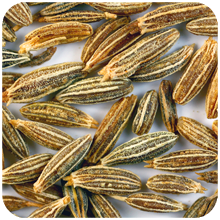
Biennial herbaceous species, cultivated as well as grow spontaneously, the stem is up to 1 m high. Pivote root is fleshy, brown, up to 2 cm thick, deep (up to 30-40 cm), but poorly branched. The stem is formed only in the second year and is erect, glabrous and fistulous, branched from the right of the base. Leaves in a rosette of leaves the first year bi or tripenate, long petiole of 20-40 cm, with narrow laciniata: in the second year, lower leaves are long-petiolate, bipennated, with 6-12 pairs of segments arranged in order of I. Flowers arranged in umbel composed of 5-15 unequal radii, each umbel has 10-13 flowers. The flowers are small, with short calyx, petals are white or pink, 1.5 mm in length. Fruit is diachene with those 2 halves are free, elongated oval, narrowed at the ends, grayish with 5 evident ribs, lighter in color.
Chemical composition – Fruits contain volatile oil consisting of carvone, limonene, dehydrocarvone, dihydrocarveol, lipids, minerals albuminoids, mineral substances starch, sugars, resins, tannoids.
Properties – Seeds are mild diuretic, expectorant, stimulate gastric secretions, aphrodisiac, galactogogue, antiviral.
Recommendation – Bronchitis, colds, neuralgia and other lung diseases, heart diseases, nervous tachycardia and circulatory disorders, laryngitis, indigestion, vomiting, constipation, bloating, aerophagia and intestinal inflammation, irregular menses, rickets, stomach cramps.
This plant is incorporated in natural remedy GASCURE Syrup.




